ANCIENT INDIA—PART 1
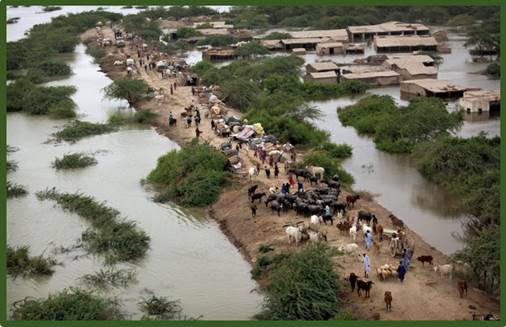
Flooding
along the Indus River during the Rainy Season:
2010
Unit
Overview
While
the Egyptians were building the pyramids at Giza, the inhabitants of the Indus
River Valley were constructing large, well-planned cites. What do we know about these people who
mastered indoor plumbing and engineered efficient sewage systems? How did geography impact the ways in which
their civilization developed? Why were
their cities eventually abandoned? You
will soon know the answers to these questions as we explore life in ancient
India. Let’s get started!
The
Geography of the Indian Subcontinent
In
southern Asia, a large land mass juts out into the Indian Ocean. This peninsula is so large that it is often
referred to as a subcontinent. Today, it is home to the countries of
Bangladesh, Bhutan, India, Nepal and most of Pakistan. Off the tip of South Asia, the island of Sri
Lanka is believed to have been part of this landform at one time. Geographers think that the Indian
subcontinent used to be an island. It slowly moved north until it collided with
Asia. This crash caused the formation of
the Hindu Kush Mountains and the Himalayas, the world’s highest mountain
range. Mount Everest, the tallest mountain on the globe, is located in the
Himalayas. The subcontinent is
surrounded on three sides by the Bay of
Bengal, the Indian Ocean and the
Arabian Sea.
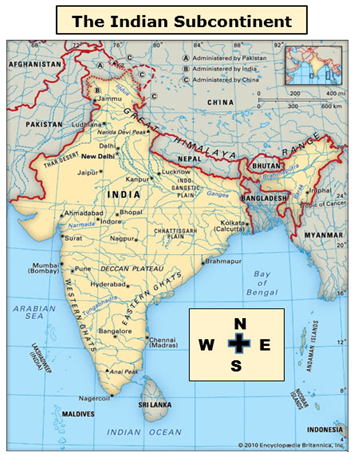
The
mountains and the seas have a major impact on the subcontinent’s climate. The peaks of the Himalayas keep the extremely
cold winds from sweeping down from the north.
However, seasonal winds, called monsoons,
bring rainy and dry seasons. This
happens because they blow in one direction during the winter and in the
opposite direction during the summer.
Beginning in October, winds from the northeast bring in hot, dry
air. In late May or early June, the
summer winds from the southwest pickup moisture from the Indian Ocean. This causes heavy rains and very warm
temperatures. Look carefully at the
images below. They were taken at the
same spot in the Western Ghats Mountains in southern India. Can you see the differences
created by the monsoons?
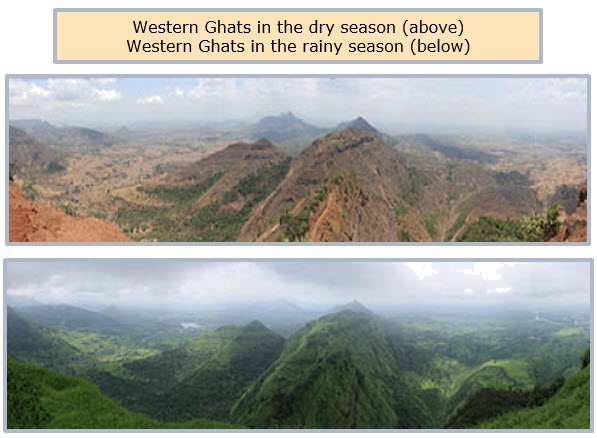
Images courtesy of Arne Huckelheim
Monsoons
occur in other spots around the globe, too. Parts of Australia, Africa and Asia also
experience them, but the ones in India produce the most extreme weather
conditions. Meteorologists, or experts
that study the weather, consider the Indian village of Mawsynram to be the rainiest place on Earth. On average, it receives 467 inches of rain
annually. Today, the monsoons, as they
have been for centuries, are a major part of life on the Indian subcontinent.
Civilization
Developed in the Indus River Valley
Along
with mountains and seas, the Indian subcontinent has several great river
systems. One of these is the Indus River, which begins in the
Himalayas and flows into the Arabian Sea. The earliest Indian civilization was
built in this river valley. It was
located in what is now modern Pakistan. In ancient times, farmers began planting
wheat and barley here. By 3000 BCE, they
were also growing cotton and producing cloth.
Like Mesopotamians and Egyptians, the people of the Indus Valley
depended on rivers with their annual floods.to water their crops and to deposit
a new layer of fertile soil.
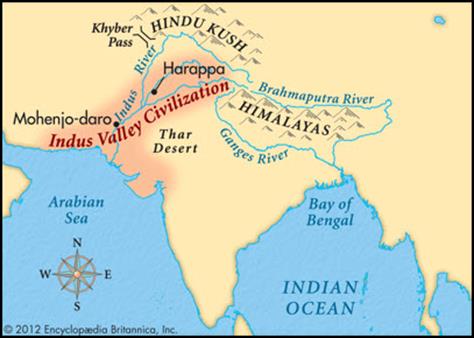
As
the food supply increased, not everyone needed to farm. Workers were able to do other things, such as
making tools and building homes.
Specialization led to the constructions of villages and towns. People also began to trade their extra food
and products up and down the river valley.
Eventually, merchants and traders built boats that could withstand ocean
travel and longer trips. These ships,
loaded with grain, cotton cloth, ivory, pearls and copper, made their way to lands
as far away as Mesopotamia. They
exchanged these goods for silver, tin and woolen cloth. A few ambitious traders even found their way
through the mountains and established trade routes overland.
The
Great Cities of the Indus Valley
Trade
brought wealth to the Indus Valley. This
offered the means to build not only towns but great cities. Archaeologists have found the remains of
almost one hundred cities within this river valley. The largest and most famous are Harappa and Mohenjo-Daro. Both cities
were surrounded by high walls and had citadel,
or fort on high ground, inside. They had
large warehouses to store grain. Each one was home to over 35,000 people. The Indus River provided the water for extensive
irrigation systems that supplied water during the dry season for farming
outside the city walls.
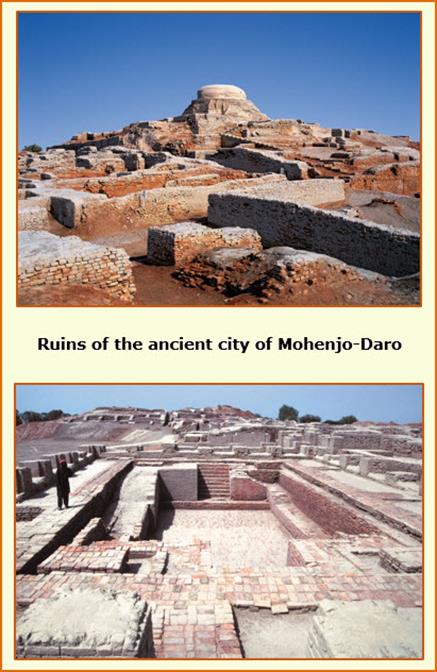
The
most amazing thing about these two cities is how well-planned they were. They were laid out in blocks in a grid
pattern similar to those followed by modern cities. There were wide, main streets and narrow, side
streets. All the buildings were
constructed with uniform, oven-fired clay bricks. Homes had indoor plumbing with baths and
drains that led to underground sewers. They
also included garbage chutes that were connected to bins on the street.
What
We Know about the Indus Civilization
The Indus civilization, also called the Harappan civilization, was spread out over
an area larger than ancient Egypt or Mesopotamia. Yet, we know much less about it in comparison
to other ancient civilizations. Because
the Harrapans cremated, or burned, the bodies of their dead, there are no tombs
filled with articles for the afterlife and no mummies to study. There are no clay tablets filled with cuneiform
or scrolls inscribed with hieroglyphics to help us understand daily life in
this ancient culture.
However,
archaeologists have found over 2,000 seals
in their excavations of Harappa and Mohenjo-Daro. They believe that these objects were used by
merchant families to label products and to identify who made them. They served the same purpose as bar codes and
trademarks do today. These seals include
carvings of animals and other symbols whose meanings are unknown. From these pieces, scholars have collected
about 500 different pictographs and symbols. Unlike hieroglyphics and cuneiform
writing, no one has yet cracked the code to decipher the language. Once someone does, we may have a greater
understanding of life in the Indus Valley.
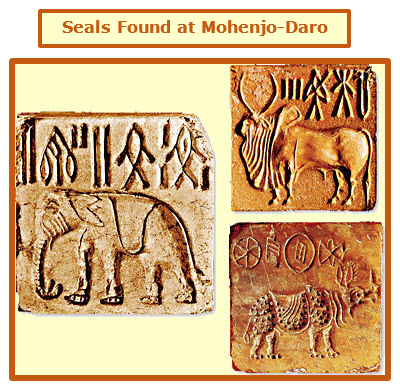
Because
the inhabitants of the Indus Valley did not leave us government documents or
written records, we know very little about their leaders and their laws. We can only make reasonable guesses based on
the evidence that we have. Most
historians agree that the Harappan civilization had a well-organized government
and strong leadership. How did they
reach this conclusion? For one thing, we
do know the merchants used a standard system of weights and measures. This had to have been ordered and enforced by
someone. The uniform size of bricks is
another clue. It indicates that
construction projects had to follow exact building codes. There also must have also been specific
standards for the layout of cities in the Indus Valley because all urban areas
were designed the same way. These, too, had to have been ordered and enforced
by someone.
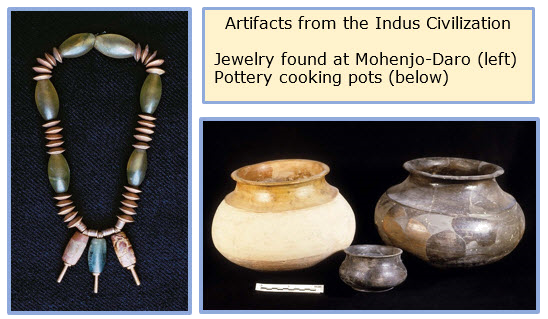
Our
knowledge of Harappan society is very limited.
Archaeological excavations have revealed that most homes were about the
same size. This seems to indicate that
the Harappan civilization may have had a greater sense of equality than ancient
Egypt or Mesopotamia. Archaeologists
have not uncovered any grand palaces or massive monuments like those built by
the Egyptians. Nonetheless, some
evidence that there were three main social classes does exist. This is based on ruins that reveal where
certain people lived within the city.
The ruling class, made up of rulers, priests and nobles, lived in the
center of the city. Merchants and
craftsmen, who made tools, pottery, jewels and cloth, occupied homes outside
the city center. Unskilled workers and
farmers made up the largest group in Harappan society. They were poor and lived in small huts.
The
story reminds us of the importance of trade to the people living in the Indus
Valley. Click on the graphic below. What do you remember about the events that
were described in the story?
Statues
and artwork found in the ruins of the Indus Valley give us some insight into the
religious practices of those who once lived there. We know that the people were polytheistic in
their beliefs. The Mother Goddess, the
source of all creation, and the Great Male God were worshipped throughout the
region. The Harappans believed in magic
and, as we said previously, burned the bodies of their dead. They thought that the gods took the ashes
that remained to heaven.
A
History Mystery
For a long time, the cities built in the Indus Valley
grew and prospered. About 1750 BCE,
things began to change. Archeologists
tell us that the cities no longer operated under strict standards. Bricks, pottery and jewelry did not have the
fine quality of those produced in earlier times. Eventually, these cities that were once
filled with people were abandoned and forgotten. Click on the graphic below. The video offers some theories that may
explain why this happened.
What
caused these cities to decline? What
happened to the inhabitants? How could
they just disappear? No one knows for
sure, but scientists and archaeologists have several ideas. For example, mud and debris in the streets of
some excavated cities could mean that a volcanic eruption devastated the river
valley. Severe earthquakes may have
blocked or changed the flow of the Indus River leaving some cities without
water and causing serious flooding in others.
It is also possible that the soil simply wore out because farmers
planted the same crops year after year. The final blow to these cities came in
1500 BCE. Large numbers of Aryans, a
nomadic people from the north, swept into the Indian subcontinent. Although they looted and destroyed what was
left of the Indus civilization, they would later build their own civilization along
the banks of another great river.
Time
for a Quick Review
Before
moving on to Unit 15, review the names and terms found in Unit 14. Be sure you can answer the “Can I” questions
with a loud “yes”.
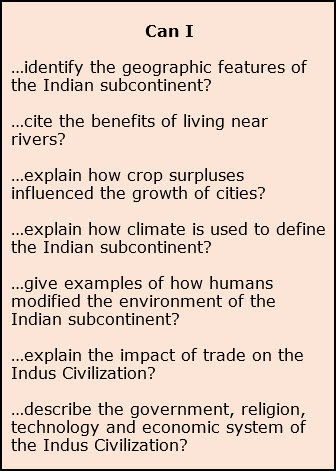

Additional Activities and Resources
Revealing
India and Pakistan’s Ancient Art and Inventions (article with quiz)

